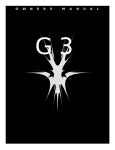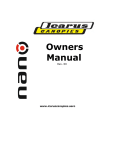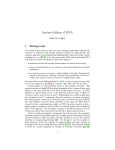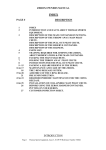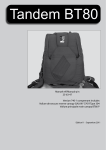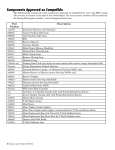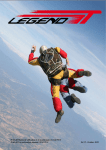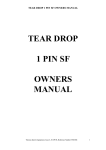Download Wings Owners Manual 11-02 Single Page Format.pub
Transcript
TABLE OF CONTENTS Revision 3 11/12/02 Introduction 3 FAA Correspondence 4 Wings Components 5 Donning Your Wings 6 Before Skydiving with Your Wings 9 Deploying Your Main 11 Malfunctions and Deploying Your Reserve 12 RSL System 16 3-Ring Release System 18 Installation of Cypres 24 Reserve Assembly and Packing 26 Main Assembly and Packing 36 Maintenance 62 Notes Back Cover 1 Skydive 2 INTRODUCTION Congratulations on the purchase of your Wings harness/ container system (Wings). Your Wings is a modern, state of the art parachute harness/container system employing advanced reserve deployment technology. Only the finest quality construction techniques and materials available in the industry were used in your Wings harness/container system. If you have never jumped the Wings before, or if you are transitioning from other types of gear, be sure to receive instruction on its use from a certified instructor. This instruction should consist of a practice session in a suspended harness or on the ground where you practice both routine and emergency procedures. This manual is not a course of instruction on how to make a parachute jump. Nor does it contain the various regulations that govern sport parachuting and related activities. It is the responsibility of the user to ensure that his/her Wings is properly assembled, maintained, packed, worn and used. It is the user’s responsibility to seek out and obtain proper training before use of the Wings harness/container system. The information and specifications in this manual are in effect at the time of printing. Sunrise Rigging International, Inc., however, reserves the right to change the Wings at any time without notice and without incurring any obligation. Please read this manual thoroughly, cover to cover, before attempting to pack or use this equipment in any way. If after you have read this manual, you find you do not understand any element, please consult a qualified rigger or a qualified instructor for operational assistance. The Wings harness/container system is approved under FAA TSO C 23 D. This assembly is limited to use by persons up to 115 kg (254 lbs.) fully equipped, and up to 150 knots. 3 4 WINGS COMPONENTS Your Wings harness/container system is shipped from the factory with a collection of components, depending on the instruction methods used and the configurations desired by the customer. These components may include: • • • • • • • • • • • • • • • • • • • • • • • • Harness/Container Reserve Static Line Reserve Closing Loop Release Handle Reserve Ripcord Reserve Pilot Chute Reserve Pilot Chute Top Plate Reserve Free Bag and Bridle Bridle for Round Reserve Reserve Control Toggles Main Risers and Control Toggles Main Deployment Bag Main Throw out Pilot Chute and Bridle Main Spring-Loaded Pilot Chute with Bridle Main Closing Loops (2) Closing Loop Elastics for Leg and Chest Straps (2) Rubber Bands for Main Deployment Bag Reserve Packing Data Card Setup for Cypres AAD AFF Left Side Jumpmaster’s Handle Main Ripcord Main Static Line Main Static Line Pilot Chute Assist Velcro Assembly 5 DONNING YOUR WINGS The Wings is custom built in a variety of container sizes, lengths, and widths. These configurations along with options make sizing of the harness and container system to the individual jumper vital to the safe operation of the system. If the system does not fit properly, the handles may be either inaccessible or may shift in free fall or under canopy, therefore causing problems that may result in injury or death. The Wings is designed to fit snugly, yet comfortably, when properly adjusted. A harness that is either too small or too large for the jumper’s body size can affect safety and comfort during a parachute jump. To adjust your Wings: 1. Put the rig on and loosely thread the leg straps. Check the leg straps for twists before threading them. 2. Tighten the leg straps so they are snug, but not so tight that they would restrict mobility in a relaxed arch or turning motion. 3. Make sure the left and right straps are evenly adjusted. Slide the excess strap through the elastic keepers and stow in the pockets on the leg pads so they won’t flop around in the air. 4. Thread the chest strap as follows: enter the adjuster from behind (next to the jumper’s chest), go around the sliding bar, and go back through between the bar and the end of the adjuster. Make sure that the folded edge of the chest strap is completely threaded so that it cannot unthread itself. (See Fig. 2) 6 5. Adjust the chest strap so the main lift webs are parallel when the chest strap is tightened. The chest strap should not restrict mobility in a relaxed arch. CAUTION: An improperly threaded chest strap will not hold the jumper in the harness. 7 CORRECT ROUTING OF: LEG STRAP CHEST STRAP 8 BEFORE SKYDIVING WITH YOUR WINGS Every jumper should do a thorough equipment check before every skydive, no matter how experienced the jumper is. Your pre-jump equipment check should follow a logical order. A thorough pre-jump equipment check includes the following checks: 1. Check the reserve pin and cable. The reserve pin should be straight and seated deep into the locking loop with the end of the pin covered by the pin protection pocket. Slide the reserve ripcord cable back and forth in its housing to ensure that it moves freely. This is especially important in sub-freezing temperatures. 2. Lift the main container pin-protector flap and check the locking pin. It must be at least halfway through the locking loop. 3. Ensure that the bridle is routed correctly, from the locking pin into the pilot chute pouch. A misrouted bridle will cause a pilot chute-in-tow malfunction. 4. Make sure both the reserve and main pin protector flaps are tucked in. 5. If your Wings comes with an AAD installed, calibrate it according to the manufacturer’s instructions. 6. If your Wings comes with a RSL System, make sure it is hooked up correctly. 7. Make sure the 3-Ring release system is assembled properly and is free of dirt or other foreign matter. 9 8. Check the position of the reserve ripcord handle. Do not remove it from the pocket unless you suspect a problem. Make sure that the handle is securely velcroed in the pocket to minimize the chance of it floating or dangling during free fall. 9. Check the 3-Ring release (cutaway) handle. It should be mated to the Velcro on the harness, and no more than ½ inch of yellow cable should be visible between the cutaway handle and the cable housing. 10. Ensure that the chest strap is threaded properly, and that it is not threaded through the reserve ripcord handle. 11. Ensure that the leg straps are threaded properly, and that the main lift web is not twisted. The free ends of the leg straps should be tucked in the leg pads. Wings has features that require a certain level of experience and training in order to be safely utilized. Before you jump your Wings, be sure to receive instruction on its use from a knowledgeable instructor. This instruction should include practicing both routine procedures and emergency procedures in a suspended harness or on the ground. It is the responsibility of the jumper to seek out and obtain proper training before flying with the Wings harness/container system. It is the responsibility of the user to ensure that the Wings is properly assembled, maintained, packed, worn, and used. This manual does not provide instruction on how to make a parachute jump; nor does it contain the regulations that govern sport parachuting and related activities. 10 DEPLOYING YOUR MAIN Before you use your Wings harness/container system for the first time, you should practice the procedures on the ground under supervision of a knowledgeable instructor. To deploy the main parachute: 1. While falling in a stable position, if possible, find your pilot chute handle. 2. Firmly grasp the handle with your right hand, while compensating for stability with your left. 3. Pull the handle from its pouch and act according to the needs of the particular deployment system you are currently jumping. 11 MALFUNCTIONS AND DEPLOYING YOUR RESERVE This section discusses the causes of some total and partial malfunctions and deploying your reserve. This section does not provide detailed instructions on coping with emergencies. It is meant only to explain the function of your Wings harness/container system. Learning the proper procedures and deciding when or if to use them is the responsibility of the user. NOTE: The following procedures for dealing with malfunctions do not consider the dependency on an AAD or RSL. Since these are back-up systems, the jumper should react as if these were not there. Total Malfunctions A total malfunction exists when the main canopy is still in its container after some effort has been made to deploy the main pilot chute. The pilot chute may or may not be trailing behind you. A total malfunction may result from a variety of factors, most of which can be prevented by proper packing, maintenance, and use of your Wings. Because you are descending at a high rate of speed, you have little time to attempt to correct a total malfunction. You should pull the reserve ripcord using a “look, reach, pull” procedure, grasping the reserve ripcord with both hands and pulling until your arms are completely extended. Because the main canopy is not out of the bag, it is not normally necessary to cutaway the main risers before pulling your reserve. Doing so wastes the limited time and altitude. 12 Pilot Chute-in-Tow The pilot chute is out behind the jumper, but does not extract the main canopy from the container RESPONSE: Assume a flat and stable position and immediately pull the reserve ripcord. It is highly unlikely that you will be able to identify or correct the cause of a pilot chute-in-tow before impact. Pilot Chute Hesitation The pilot chute may become trapped in the turbulent air over your back and simply hover in the burble. RESPONSE: Roll over on your side momentarily. This should blow the pilot chute off your back or out of the turbulent air. While maintaining altitude awareness, you should try all possible methods of getting the pilot chute into ‘clean’ air, because simultaneous deployment of the main and reserve canopies can occur in this situation. If the pilot chute does not get ‘clean’ air and extract the main within a safe opening altitude, you should assume a flat and stable position and pull the reserve ripcord. Lost or Stuck Deployment Handle You may not be able to locate the deployment handle on the pilot chute, or if you do locate it, you may not be able to extract the pilot chute. RESPONSE: You should look at the deployment handle. If you cannot see it or feel it, you should assume a flat and stable position and pull the reserve. If you can locate it, but two hard pulls will not extract the pilot chute from its pouch, you should assume a flat and stable position and pull the reserve. Partial Malfunctions A partial malfunction results when the main canopy comes 13 out of the container and extends above your head but does not open correctly. Most partial malfunctions result from incorrect packing, poor body position upon deployment, or problems with the main canopy itself. Some partial malfunctions can be corrected in the air, may not require pulling the reserve, and can be landed safely. Identifying and dealing with such situations is your responsibility. It is important to clear your air before pulling your reserve. However, in some situations, waiting too long between cutting away and pulling your reserve can result in serious injury or death; and cutting away and pulling your reserve simultaneously or in rapid succession may result in an entanglement and result in serious injury or death. Experience thus far has shown that a “two-step” method is most effective. When presented with a partial malfunction that requires the use of your reserve, you should arch your back and tuck your legs behind you as best you can given the malfunction. You should look down at the cutaway and reserve handles. Grasp the cutaway handle and peel it away from the main lift web. Look at the reserve ripcord handle, pull the cutaway handle to full arm extension and throw it away, and immediately grasp the reserve ripcord handle with both hands and pull to full arm extension. AAD Deployment You will find yourself under your reserve if you descend below the preset altitude at a high rate of speed, or if your AAD was improperly calibrated. If the main container is still closed, you should land under the reserve canopy. If the main container is open but the main is not inflated, you should cutaway the main. If both the reserve and main canopy are inflated, you should respond as you were trained by your instructor for your particular 14 particular canopy. Other Emergencies You may be faced with any number of emergencies not discussed here, including those in the aircraft, during climb-out or exit, in free fall, under canopy, and during landing. As stated previously, training for any and all emergencies must be provided by a currently rated instructor, and it is user’s responsibility to maintain current training on all aspects of using Wings Harness/ Container System. 15 THE RSL SYSTEM The main concept of the Reserve Static Line Lanyard (RSL) system is that a lanyard is attached from the left main riser to a ring through which the reserve ripcord is routed. Upon cutting away a malfunction, the lanyard automatically pulls the pin of the reserve ripcord, which results in a minimum loss of altitude before the reserve is deployed. The RSL system is used primarily during the student and post-student phase, particularly during the transition to more advanced equipment. NOTE: The RSL is only a backup to manually pulling the reserve after a cutaway. As with any AAD, do not rely on an RSL to pull the reserve. 16 PROPER ROUTING OF RSL 17 THE 3-RING RELEASE SYSTEM The 3-Ring Release System was invented by the Relative Workshop in 1976. It was the first release that allowed parachutists to jettison their main canopies in one motion by simply pulling a single handle. Not only is the 3-Ring easier to operate than previous canopy release systems, it is also more reliable. The great reliability of the 3-Ring system results from the proper functioning of every one of its individual components. Therefore, the owner should not modify the system in any way. Knowing how the 3-Ring release works will help you assemble and inspect it properly. Begin by peeling the release handle from the velcro on the harness. Peeling, rather than pulling, makes it easier to separate the handle from the webbing. Look behind the risers near the harness and observe the movement of the yellow cable as you pull the handle. When the cable clears the white loop, the release is disengaged. Now slowly pull one of the risers off the harness. As you pull, you’ll notice that the white loop gets pulled through the grommet by the action of the smallest ring. Because of the mechanical advantage provided by the 3-Ring design, only a force of approximately a pound on the top ring keeps the release together. It is also important to understand one of the properties of the nylon components of the system. When nylon stays in the same position for a long time, it begins to conform to that position, or take a “set.” If the 3-Ring release system stays assembled for too long, the nylon can become so stiff that the low drag from a malfunction (such as a streamer) will not pull the riser off the ring. 18 The 3-Ring release system must be disassembled, flexed and inspected every month. Procedures for this are listed in the care and maintenance chapter of this section. Generally, it is NOT recommended that the risers be attached to the harness when new and “forgotten”. Like all skydiving gear, the 3-Ring Release should be carefully inspected and operated on a regular basis. The procedures below should be done at least every month. This is especially important if the rig has not been used for a month or more, such as during the winter. Immediate inspection is required if it has been subjected to some abuse such as a drag across the runway, a water landing or exposure to a lot of dust or sand. It’s important to maintain the system even more frequently in humid, muddy or freezing conditions. If your Wings becomes immersed in mud or muddy water, clean the 3Ring release system with a mild solution of soap and water. Any rusted components must be replaced. 1. Every month operate the 3-Ring release system on the ground. Extract the cable completely from the housing and disconnect the risers. 2. While the system is disassembled, closely inspect it for wear. Check the white locking loops (the ones that pass over the smallest ring and through the grommet) to be sure they are not frayed. 3. Check the velcro on the breakaway handle and main lift web to be sure it is clean and adequately holds the handle. 4. Check the cable ends for a smooth finish. The ends are finished at the factory to have a smooth, tapered surface. This prevents the cable from hanging up in 19 the loop. Check the cable ends and consult a rigger or the manufacturer if a burr or “hook” is present. 5. Check the stitching, including that which holds the large rings to the harness. 6. Check the 3-Ring release housings for solid handtacking and proper stretch. The housing ends lay at the chest strap area, pull downward on these housing ends and check that they do not move downwards more than ½ inch. Pull the housings from the free end and expect 1-2 inches of movement. 7. Take each riser and vigorously twist and flex the webbing near where it passes through each ring. The idea is to remove any set or deformation in the webbing. Do the same thing to the white loop. 8. Check the housings for dents or other obstructions. Use the cable to do this. 9. Clean and lubricate the release cable with a light oil such as “3-in-1” brand or silicon. Put a few drops on a paper towel and firmly wipe the cable a few times. A thin, invisible film should remain – too much will attract grit and dirt, or the oil will require more force to extract the cable during a breakaway. 10. Inspect the fittings at the end of each housing. If one of these fittings were to come off the housing, a riser might release prematurely. 11. If any wear is found, consult a rigger before using your Wings. 12. Reassemble the system. Double check it. Make sure the risers aren’t reversed. 20 Assembly Before assembling the 3-Ring release, make sure the risers are not twisted or reversed. Lay your Wings face down, as you would to pack it. 1. Thread each cable into its housing and stick the handle to the harness. The handle should be positioned as close to the ends of the housings as possible so that no cable is exposed. 2. With the rings of the riser facing toward the floor, pass the middle ring on the end of the riser through the large harness ring from above. Fold it back toward the canopy and risers. 3. Thread the smallest ring through the middle ring in the same way, but make sure it does not pass through the large ring. 4. Bring the white loop over the small ring only and then through the riser grommet so it pokes out the back of the riser. Continue threading the white loop through the grommet on the end of the cable housing. The flat side of the cable housing grommet should be against the riser. 5. Thread the yellow cable through the white loop, making sure the loop is not twisted. Be careful with the cable so you do not bend it too sharply or kink it. Insert the free end in the channel on the back of the riser. 21 Pre-Jump Inspection Before jumping your Wings, check the 3-Ring release system for the following. 1. Each ring passes through only one other ring. 2. The white loop passes through only the small ring. 3. The white loop passes through the grommet on the end of the cable housing without twisting. 4. Nothing passes through the white loop except the yellow cable. 5. The 3-Ring release handle is securely stuck to the harness, and no more than 1/2” of the cable is visible between the handle and the cable housings. If your release handle has a tendency to hide itself under your main lift web, undo the velcro and twist the handle in a clock-wise rotation (when wearing rig) so the handle will stick-out and slightly forward for a better grip. 22 23 INSTALLATION OF CYPRES Read the Cypres owner’s manual and become familiar with the different components of the Cypres unit. Insert the processing unit into the spandex pocket provided on the bottom wall of the reserve. Route the release unit through the pocket on the reserve floor plate, out the slot and through the elastic housing. Stow excess cable in the Cypres pouch. Route the control unit through the channel and out the top. Insert the control unit into the slot at the top of the reserve so that the display is visible through the window on the backpad. Stow the excess cable in the Cypres pouch. Installation is complete. 24 25 RESERVE ASSEMBLY AND PACKING This chapter deals with the procedures for assembling and packing a ram-air reserve canopy into your Wings Harness/Container System. Assembly and packing of the reserve must be accomplished by an FAA certified Senior Rigger or Master Rigger, or by the manufacturer of the harness/container system. Only Wings Freebags, Reserve Pilot Chutes, and Reserve Control Toggles may be used with the Wings Harness/Container System. *PLEASE REFER TO ILLUSTRATIONS AT END OF CHAPTER FOR THE FOLLOWING INSTRUCTIONS. REQUIRED TOOLS: One temporary pin One pull up cord One packing paddle .22 caliber rifle cleaning rod 1. Make a thorough inspection of all components of the reserve parachute. a. b. c. d. e. 2. Reserve pilot chute Reserve bridle Free-bag Reserve canopy, lines, slider, connector links Harness/container system Follow the canopy manufacturer’s directions for the inspection, attachment to risers, routing of control lines, attachment of control toggles, and for flaking and folding the reserve canopy. 26 3. Setting the brakes: Your Wings harness is equipped with a unique toggle system that facilitates complete stowage of excess steering line. Pull the control line down until the brake loop just passes through the guide ring. Insert the toggle through the brake loop. Fold the excess control line and insert it under the Velcro flaps. Insert the toggle into the lower pocket. 4. After following the manufacturer’s instructions for your particular canopy, fold the bottom of the folded reserve back and on top of itself making approximately a 6 inch S-fold. Kneeling on this fold, carefully part the two top half of the canopy into two halves, forming two equal “ears.” 5. While maintaining control of the folded canopy, place it directly over the open mouth of the freebag. Fold each canopy “ear” in half and stuff into its respective side of the freebag. Close the split halves of the freebag by routing the safety loop through its respective grommet. Close and lock the mouth of the bag by making two stows with the suspension lines through the “safety stow.” 27 6. After the two locking stows are made, stow the remainder of the suspension lines (to within 6” to 12” of the connector links) in the line-stow pouch on the back of the pouch. Your Wings freebag is equipped with a “Velcro safe” line stow pouch. To close the pouch, insert the pile Velcro into the hook velcro pocket under the data label. The lines must enter and exit the line stow pouch in the center. 7. At this point, make sure the ripcord handle is stowed in its pocket and the cable is routed properly through the housing, the RSL ring (if equipped) and the guide ring located at the top of the reserve container. Insert both the ripcord and the top reserve flap through the sleeve on the pin cover flap. 8. Lay the reserve risers in the container so that the connector links are in the lower corners of the container. If there is a Cypres installed, pass the closing loop up through the release unit (“Cutter”). Pass the pull-up cord through the closing loop, then thread it through the grommet in the bag. Lay the bag in the container with the line-stow pouch on the under side, and route the bridle out the bottom left of the container. 9. Close the right and left side flaps and secure with the temporary pin. 10. “S” fold the entire bridle approximately 4” in length and place it underneath the two side flaps at the bottom center of the container, filling the space between the area under the midflap. Leave approximately 36” (1 meter) of the bridle out of these 28 folds. 11. Your Wings reserve pilot chute is equipped with a removable top plate (“cap”). At this point, verify that it is attached securely. The 2 snap straps on the pilot chute must pass through the holding tape on the “cap” before securing the snaps. 12. Pass the pull-up cord up through the pilot chute and out through the top plate. (This is easily accomplished with the .22 caliber rifle cleaning rod mentioned in the list of required tools.) Seat the lower end of the pilot chute on top of the side flaps, and keeping the pull-up cord tight, gather all of the pilot chute fabric between the coils of the spring and compress the spring. Lock with the temporary pin. At this point check the length of the closing loop. If the pilot chute top plate can rock back and forth or from side to side, the loop is too long. Shorten the loop so that when the pilot chute is compressed and locked with the temporary pin, the top plate will be firmly seated in the nest formed by the “molar” shape of the bag and the side flaps. 13. Then fold the excess bridle over the two side flaps perpendicular to the last folds and tuck it under the top plate (“cap”). 14. Verify that the top flap passes through the sleeve on the pin cover flap. Close the top flap and secure with the temporary pin. 15. Close the bottom flap and secure with the ripcord pin, making sure the temporary pin has been removed. Slide the end of the pin under the protective cover on 29 the bottom flap. 16. Seal the reserve container and log the work done on the packing data card and in your rigger’s logbook. Place the completed data card in the pocket provided on the backside of the left Main lift web. Secure the pin cover flap by inserting it into the bottom flap protective cover. 17. COUNT YOUR TOOLS. 30 RESERVE TOGGLE ASSEMBLY RSL/RIPCORD ASSEMBLY 31 RESERVE FREEBAG ASSEMBLY SEQUENCE Step 1 Step 2 Step 3 Step 4 32 RESERVE CONTAINER CLOSING SEQUENCE Step 2 Step 1 Step 3 Step 4 33 RESERVE CONTAINER CLOSING SEQUENCE CONTINUED Step 6 Step 5 Step 8 Step 7 34 RESERVE CONTAINER CLOSING SEQUENCE CONTINUED Step 10 Step 9 35 MAIN ASSEMBLY AND PACKING This chapter deals with the procedures for assembling and packing the main canopy into your Wings harness/ container system. Assembly and packing of the main must be done by an FAA certified rigger or by the person making the jump. *PLEASE REFER TO ILLUSTRATIONS AT END OF CHAPTER FOR THE FOLLOWING INSTRUCTIONS. 1. Follow the canopy manufacturer’s instructions for the inspection, attachment to risers, installation of slider bumpers, routing of control lines, and attachment of control toggles. 2. Pass the pilot chute bridle down through the grommet in the top of the deployment bag and attach it to the top of the main canopy. Be sure that the stop-ring/ block on the bridle is between the bag and the pilot chute. 3. Setting the brakes: Your Wings harness is equipped with a unique velcroless toggle system which facilitates complete stowage of excess steering line. Pull the control line down until the brake loop just passes through the guide ring. Insert the toggle through the brake loop and into the upper stow pocket on the riser. Fold the excess control line and insert it into the lower toggle pocket. Insert the toggle into the lower pocket on top of the excess control line. 4. At this point, refer to the canopy manufacturer’s instructions. 36 5. Stack the canopy in “S” folds keeping the slider up against the canopy and keeping the slack out of the lines. The stacked canopy should be slightly wider than the bag. 6. Pull the bag over the canopy. Try to fill the corners and sides of the bag to distribute the bulk evenly and avoid forming a lump in the middle. If you have a “split” bag, close the split flaps with the locking stows. 7. Make the locking stows with the suspension lines to close the mouth of the bag. Note: Always make sure that the rubber bands used for the locking stows and line stows are strong and in good condition. 8. Pull the bridle out the top of the bag until the metal ring of the canopy is seated against the grommet of the bag. Be sure there is no canopy fabric between the ring and the grommet. Now stow the remainder of suspension lines across the bottom of the bag in the rubber bands at each end. Leave 12” to 15” of lines unstowed between the bag and the connector links. 9. Lay the risers in the “trough” between the sides of the reserve container and the riser covers, and place the connector links in the lower corners. Set the bag on top of the main container. Close the tuck flaps on the riser covers, making sure the risers lay on top of the yoke flap. 10. Placing the bag in the container: There are two different ways the bag may be placed in the container. 37 A. Conventional method: Place the bag in the container so that the mouth of the bag is facing the bottom and the line stows are against the backpad. This method is preferred for wider containers that are “thin.” B. Optional method: Place the bag in the container so that the mouth is facing the backpad with the line stows up against the reserve container. This method is preferred for narrow rigs where the main container is short and thick. Use whichever method suits your container size and packing style. 11. Kneel on the bag and pull up the main container side flaps until the bag fills the container. FOR CONTINUED INSTRUCTION, CHOOSE THE APPROPRIATE DEPLOYMENT FOR YOUR RESPECTIVE CONTAINER FROM THE FOLLOWING: • THROW OUT PILOT CHUTE -BOC (page 39) -ROL (page 40) • PULL OUT PILOT CHUTE (page 41) • SPRING LOADED PILOT CHUTE (page 42) • STATIC LINE (page 43) • STATIC LINE/PILOT CHUTE ASSIST (page 44) 38 THROW OUT PILOT CHUTE DEPLOYMENT MAIN CONTAINER PACKING B.O.C. Pilot Chute 1. The bridle should be routed towards right top corner of the container. 2. Thread the pull-up cord through the closing loop. Close the bottom flap, then the top flap, then the right side flap, and then the left side flap. Insert the curved pin through the closing loop and remove the pull-up cord. 3. Ensure that there is at least 3-4 inches of slack bridle between the pin and the point of exit from the side flap. Stuff this slack under the right side flap. 4. Lay the pilot chute out flat with the mesh side up. Sfold the bridle on top of the mesh so that approximately 2 feet remains between the pin and the pilot chute. Fold the pilot chute in half over the bridle. Now fold the curved side up to a point just under the handle. 5. Fold one side into the center, making the folds as wide as the handle. Fold the other side in the same manner. 6. Insert the folded pilot chute into the B.O.C. pouch. 7. If you have a freestyle handle, tuck the handle’s tab securely into place under the right side flap. Stow any excess bridle and close the main pin cover flap. 39 MAIN CONTAINER CLOSING FOR THROW-OUT PILOT CHUTE DEPLOYMENT R.O.L. Pilot Chute 1. The bridle should be routed towards right top corner of the container. 2. Thread the pull-up cord through the closing loop. Close the bottom flap, then the top flap, then the right side flap, and then the left side flap. Insert the curved pin through the closing loop and remove the pull-up cord. 3. Ensure that there is at least 3-4 inches of slack bridle between the pin and the point of exit from the side flap. Stuff this slack under the right side flap. 4. Lay the pilot chute out flat with the mesh side up. Sfold the bridle on top of the mesh so that approximately 2 feet remains between the pin and the pilot chute. Fold the pilot chute in half over the bridle. Now fold the curved side up to a point just under the handle. 5. Fold one side into the center, making the folds as wide as the handle. Fold the other side in the same manner. 6. Insert the folded pilot chute into the pouch on the leg pad. 7. Mate the bridle Velcro with the Velcro on the harness/ container. Be very careful that the bridle does not go under or around any part of the harness. Stuff the excess bridle under the right side flap. Close the main pin cover flap. 8. Dress up the riser covers and tuck flaps, if needed. 40 MAIN CONTAINER CLOSING FOR PULL-OUT PILOT CHUTE DEPLOYMENT 1. Thread the pull-up cord through the closing loop. Arrange the bridle in folds six to eight inches long, and lay the folded bridle across the upper part of the bag. Be sure NOT to tuck these folds down between the bag and the bottom of the reserve container. To do so may retard the action of the pilot chute. Using your pull-up cord, close the bottom flap. 2. Loosely fold the pilot chute and lay it across the bag. IMPORTANT!!! THE HANDLE AND PIN MUST EXIT THE CONTAINER AT THE LOWER RIGHT SIDE! 3. Close the top flap keeping the handle and pin outside the container at the lower right. Tuck the handle securely into place under the right side flap. 4. Close the right side flap, then the left side flap. Secure with the straight pin and remove the pull-up cord. 5. Tuck the slack in the tape under the right side flap. 6. Close the main cover pin flap. 7. Dress up the riser covers and tuck flaps, if needed. 41 MAIN CONTAINER CLOSING FOR SPRING LOADED PILOT CHUTE DEPLOYMENT 1. Before starting to close your main container insert your main ripcord handle. 2. S-fold the bridle left to right on top of the main D-bag. 3. Place main pilot chute on top of the folds and compress the pilot chute and simultaneously gather all the pilot chute. 4. Your closing loop should be placed to bottom flap of your main container. Pull your closing loop through the top flap of the main container with your pull-up cord and close bottom and top flap. 5. For the ease of packing keep using your knee to hold down the pilot chute and use your pull-up cord to close right side flap of the main container. 6. Use your pull-up cord to close the left side flap and insert your ripcord cable through the closing loop. Remove your pull-up cord and close the main pin cover flap by tucking it under the center flap slot. 7. Dress up your container for the next skydive. 42 MAIN CONTAINER CLOSING FOR DIRECT BAG STATIC LINE DEPLOYMENT When closing the main container by using the static line deployment you can use either the loop of the bottom flap or the loop which is attached to the wall between the reserve and main container. 1. Route your static line out of the container towards right top corner of the container, and by using your pull-up cord close the bottom and top flap of the container. 2. By using your pull-up cord close the right side flap of the main container. 3. By using your closing loop close the left side flap of the main container. 4. Insert the curved pin, which is attached to static line, through the closing loop and remove your pull-up cord. 5. When starting the static line folds, make sure that the first rubber band is snug and keeps the pin not to fall out during the climb out. Fold the static line left, right left manner onto provided loops. 6. Use double or even triple folds on the static line to make sure that all the static line will get stowed away for the safe use of the static line. Tug the tip of the static line hook under the mains side flap and close the pin cover flap. 7. Dress up your container for the next skydive. 43 MAIN CONTAINER CLOSING FOR STATIC LINE PILOT CHUTE ASSIST When closing the main container by using pilot chute assist you have to use the closing loop at the bottom flap of the container and you have to use the velcro assembly designed to use for this application. The webbing loop with pile velcro should be attached to the bottom of the pilot chute and the webbing loop with hook velcro should be attached to the end of the staticline. Before you start closing your container, mate the two velcros. 1. S-fold the pilot chute bridle on top of the main bag and place the velcroed attachment on top of the s-folds. 2. Place main pilot chute on top of the folds and compress the pilot chute and simultaneously gather all the pilot chute material in between the coil of the pilot chute spring. 3. For the ease of packing use your knee to hold down the pilot chute. Pull your closing loop through the top flap of the main container with your pull-up cord and close bottom and top flap. 4. For the ease of packing keep using your knee to hold down the pilot chute and use your pull-up cord to close right side flap of the main container. 5. Use your pull-up cord to close the left side flap and insert the curved pin of the static line through your closing loop. Remove your pull-up cord. 6. When starting the static line folds, make sure that the first rubber band is snug and keeps the pin from falling out during the plane ride and climb out. Fold the static 44 line left-right-left manner onto provided loops. 7. Use double or even triple folds on the static line to make sure that all the static line will get stowed away for the safe use of the static line. Tug the tip of the static line hook under the mains side flap and close the pin cover flap. When not in use, always keep the staticline hook in closed position to prevent the hook from snagging any part of the container . 8. Dress up your container for the next skydive. 45 VELCROLESS TOGGLE Step 1 Step 2 46 MAIN CANOPY AFTER FLAKING & FOLDING 47 MAIN BAG PACKING Step 1 Step 2 48 THROW-OUT MAIN CONTAINER Step 1 Step 2 49 THROW-OUT PILOT CHUTE 50 B.O.C. MAIN DEPLOYMENT THROW-OUT R.O.L. MAIN DEPLOYMENT 51 PULL-OUT MAIN CONTAINER Step 1 Step 2 Step 3 52 PULL-OUT MAIN CONTAINER CONTINUED Step 4 Step 5 53 SPRING LOADED PILOT CHUTE MAIN DEPLOYMENT Step 1 Step 2 54 SPRING LOADED PILOT CHUTE MAIN DEPLOYMENT CONTINUED Step 3 Step 4 55 SPRING LOADED PILOT CHUTE MAIN DEPLOYMENT CONTINUED Step 5 56 STATIC LINE DIRECT BAG DEPLOYMENT Step 1 Step 2 Step 3 57 STATIC LINE DIRECT BAG DEPLOYMENT CONTINUED Step 4 Step 5 Step 6 58 STATIC LINE DIRECT BAG DEPLOYMENT CONTINUED Step 5 59 STATIC LINE SPRING LOADED PILOT CHUTE ASSIST DEPLOYMENT Step 5 Step 6 60 STATIC LINE SPRING LOADED PILOT CHUTE ASSIST DEPLOYMENT Step 7 Step 8 Step 9 61 MAINTENANCE AND CARE Your Wings will last longer, look better and function correctly if it is maintained. Your Wings actually requires very little maintenance unless it is subjected to unusual conditions such as jumps into salt water or a muddy landing. The best approach in maintaining your rig is to periodically spend a few minutes examining every detail on it. This inspection should be done at least every month. If any wear or damage is found, have it fixed immediately. Putting off repairs might result in a malfunction. In addition to inspecting the rig yourself, ask your rigger to inspect the entire assembly every time the reserve is repacked. PARTICULAR ATTENTION SHOULD BE GIVEN TO THESE AREAS: Breakaway System – Refer to the 3-Ring section in this chapter for detailed information on inspecting the canopy releases. Reserve System – This includes the reserve ripcord, locking loop, pin, handle, housing, container and associated sewing. You should not attempt any repairs or modifications to any of these items unless you are a rigger. You can, however, spot little problems before they become major. Harness – The harness should be inspected periodically for broken stitching or frayed webbing. 62 Main Container – Inspect the plastic stiffeners in the container flaps and replace any that are broken. Replace any grommets that are badly deformed or are pulling out of their setting. Main Pilot Chute – (1)Check the center line (the length of nylon tape inside the pilot chute that extends from the handle to the base) of the main pilot chute. It must be firmly sewn at each end; there must be no broken stitches or torn fabric. (2)Inspect the seam that joins the pilot chute mesh to the pilot chute fabric. If the mesh is torn or badly frayed, replace the pilot chute. Locking Loop – The main container is held shut with a locking loop made of nylon suspension line sheathing. This loop is subject to wear. If it wears out and breaks, the main canopy may release prematurely and a malfunction may result. Replace the loop with a duplicate if wear is noticed. Your Wings is manufactured mostly from nylon. Nylon is very durable but is susceptible to damage from several sources: Sunlight – The ultraviolet rays in sunlight quickly and permanently weaken nylon. Keep your Wings out of direct sunlight as much as possible. Acids – Nylon is also damaged by acids. Keep your Wings away from hangar floors, dirty car trunks and similar areas where acids may be found. If such contamination does occur, immediately and thoroughly wash the rig with plenty of warm soapy water. Until a rig can be washed, baking soda will quickly neutralize most acids. If acid damage occurs or is suspected, a rigger should thoroughly inspect your Wings Harness/Container System. 63 Oils and Grease – Most petroleum compounds do not weaken nylon. They simply stain it. Such stains should be promptly removed by a rigger using the proper petroleum solvent. Water – Water will not structurally damage your Wings, but prolonged agitation in clear water weakens webbing or may cause some fabric and tape colors to run. Salt water may damage nylon and rust hardware if not promptly and thoroughly washed off with plenty of fresh water. Your rig will maintain its new appearance longer if it is kept dry. Soil – Soil may damage your Wings Harness/ Container System. Brush off the soil after it has dried and, gently wash with warm soapy water. Be sure that the soil is not in the housings, snaps, 3-Ring release or reserve ripcord pins or loops. Consult a rigger if your rig is heavily soiled or extremely dirty. Sand – Fine sand will weaken and cut webbing and fabrics of all kinds. Prolonged exposure to sand will shorten the life of the entire parachute assembly. Abrasion – Nylon quickly frays if dragged over concrete or other rough surfaces. Do not drag your rig on the concrete while packing. 64
































































